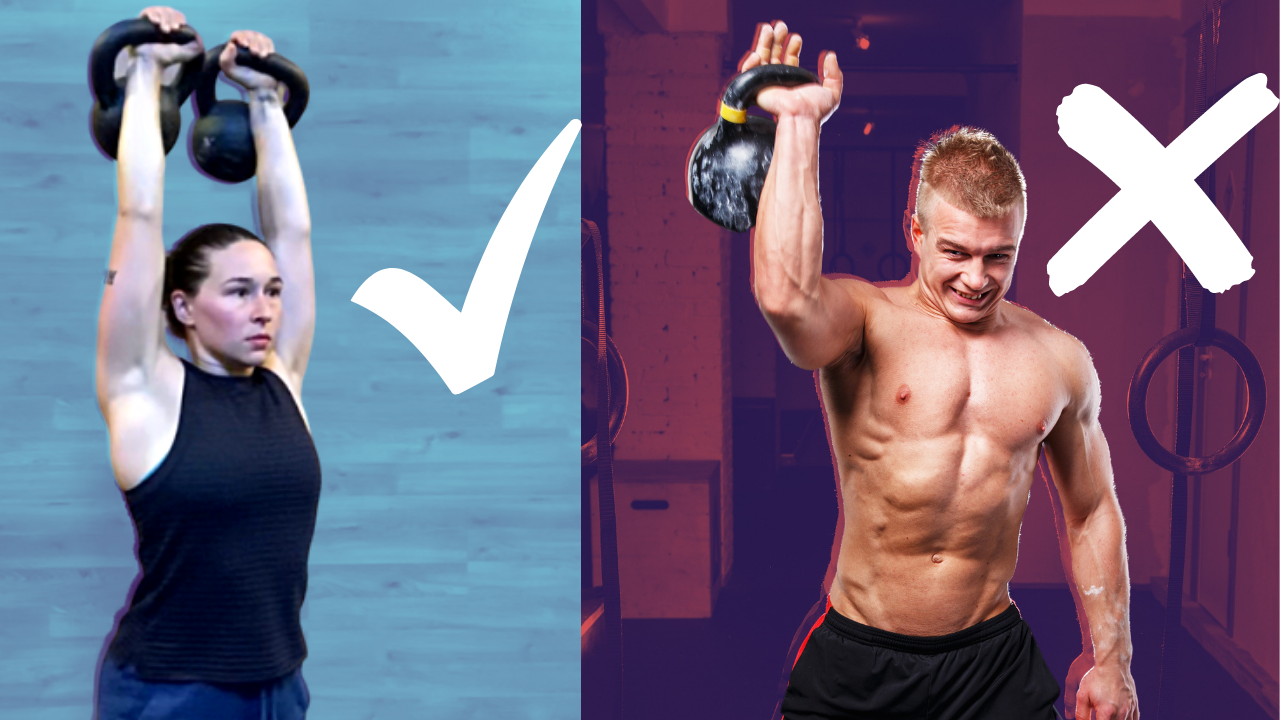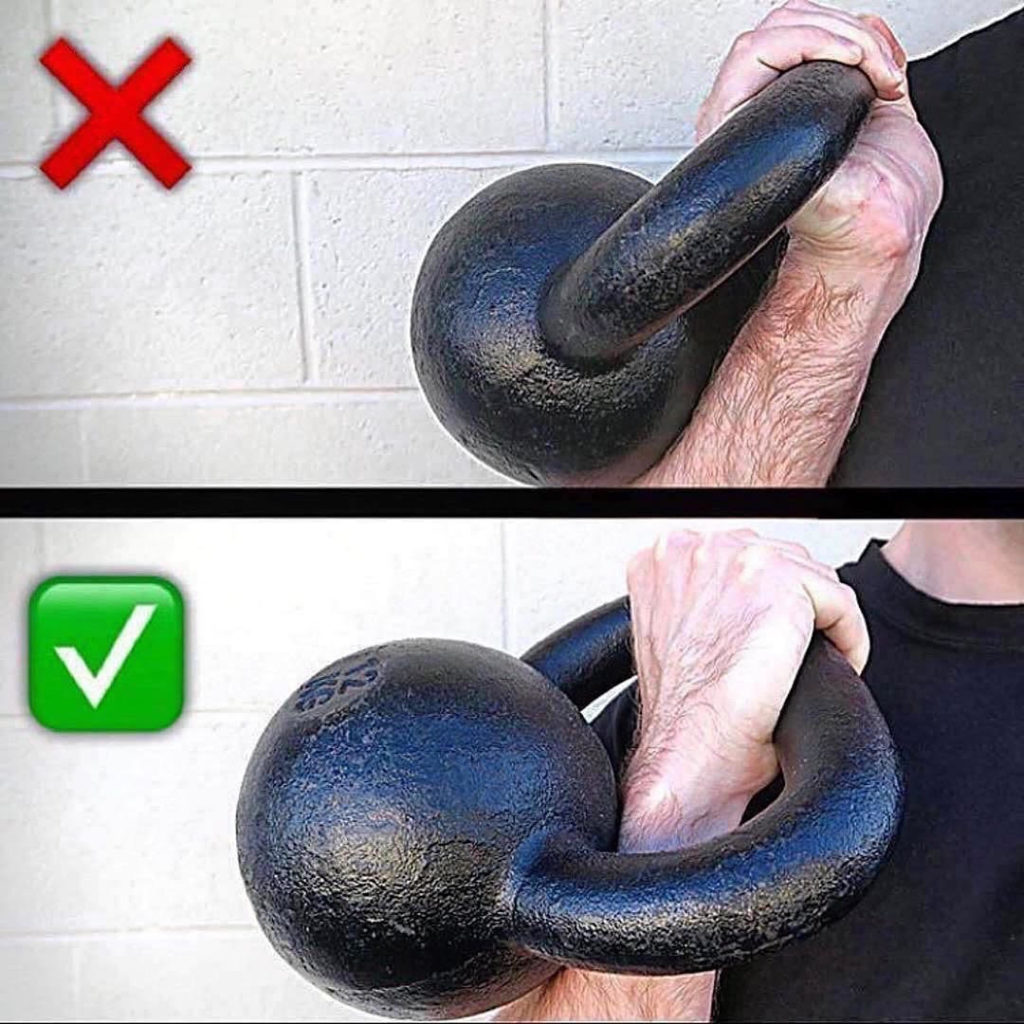The strict military press is pound-for-pound the hardest of the basic lifts to perform:
A weight (kettlebell, barbell, household pet) is held motionless at the shoulders, then pressed vertically into a full arm lockout with minimal leaning or movement from the rest of the body.
Overhead pressing is a challenge to any lifter’s shoulder mobility and total-body stability. Plus, the prime movers include the relatively small muscle groups of the delts and triceps.
All this to say – there’s no room for error.
Even a slight change in technique can mean the difference between a smooth, strong press and a tweaked shoulder.
The kettlebell press is a fantastic restorative upper-body strength builder, but you gotta do it right. Lifting isn’t rocket science, but there are some all-too-common mistakes we need to address to guarantee you get strong with a kettlebell the safe way.
The last place you can afford sloppy technique is where heavy iron lies perched over your head.
Kettlebell Press Mistake #1 – Pressing with a bent wrist
We all have a natural tendency to grip heavy objects in the middle of the hand. It’s where we feel we have the most control over whatever we’re lifting.
And if you’re pressing dumbbells, you can get away with a center-hand grip…
But that same orientation with a kettlebell will put you in the “broken wrist” position:
The solution here is to stack and squeeze:
Line up the handle in a diagonal so that the handle, wrist, and elbow stack up vertically. You can even gooseneck the wrist a little bit. This is going to help you press in the most safe and efficient way possible.
One more tip here, as you begin the press, squeeze the handle tight (especially through your pinky side). When your grip is aligned just right, you’ll barely even feel the kettlebell. It’ll just feel like you’re raising a heavier arm.
Kettlebell Press Mistake #2 – Pressing with a loose body
Strength is applied tension.
The military press is not just a shoulder exercise – it’s a full-body effort.
The shoulders, and every muscle group beneath them, have a job to do. In fact, the shoulders and arms come into play last after the rest of the body has tightened up to provide proper stability.
Imagine launching a space shuttle from the top of a skyscraper. You’d obviously need a strong foundation, but that’s just the start. Every floor would need to be equally as stable all the way to the top.
That’s how you should think about pressing – fortify your body from the ground up and the press happens smoothly.
Here’s the order of operations:
Grip the ground with your toes, flex the quads, lock the glutes, brace the abs, squeeze the lats and pecs and THEN press. Not only is this the strongest way to press, it’s the safest, too.
Kettlebell Press Mistake #3 – Pressing too heavy
Kettlebell weights often come in 4-kilogram increments. That jump equates to a huge increase in relative intensity, for the weight ranges we commonly use with the military press.
For example, let’s say right now you’re pressing the 16 kg (35 lb) kettlebell. The next size up is 20 kg (44 lb) – a 25% increase! Don’t be shocked when that new bell barely budges off your shoulder.
It’s for this reason that steady linear progression just doesn’t translate well to kettlebell training. You’ll quickly bump up against your max weight and get stuck.
The solution is to completely own a given weight before making the jump. Stick to the lighter kettlebell and build your work capacity there with press variations and higher volumes.
I recommend training up to 5 sets of 5 reps on each arm before moving to the next bell size.
Here’s a very simple 6-week pressing cycle working up to 5×5:
Week 1: 3×3
Week 2: 3×5
Week 3: 4×3
Week 4: 4×5
Week 5: 5×3
Week 6: 5×5
Kettlebell Press Mistake #4 – Pressing from a sloppy clean
The fourth and final mistake is pressing after a sloppy clean or unstable rack position. This ties right back to mistake #2 where we focused on total-body engagement.
The clean is the first step in any military press.
Whether you clean from the ground, from a swing, or use two hands in a cheat clean, the clean sets up your foundation for the press.
An efficient clean creates alignment and engagement for a smooth transition into the press. An inefficient clean wastes energy, makes every press feel harder, and can really jack up your shoulder and neck.
The solution is to focus on your clean technique and practice until your reps are strong and consistent.
Closing Thoughts
We humans seem to love throwing heavy weights over our heads. The kettlebell press, snatch, and get-up are always crowd favorites because, A – they look cool, and B – they build old-school shoulder strength like nobody’s business.
But hoisting heavy iron over one’s noggin is not a risk-free endeavor.
Keep yourself strong and safe with these tips (and some common sense, please)… or else I’m making you workout in a hardhat.


